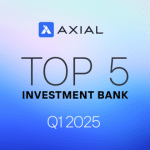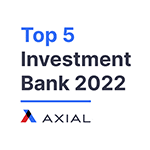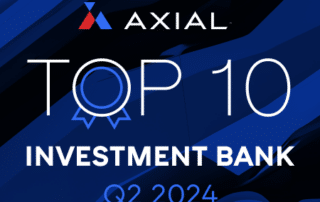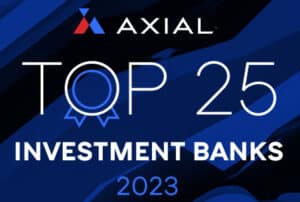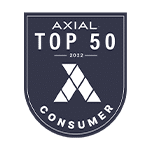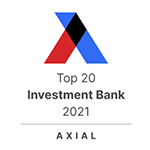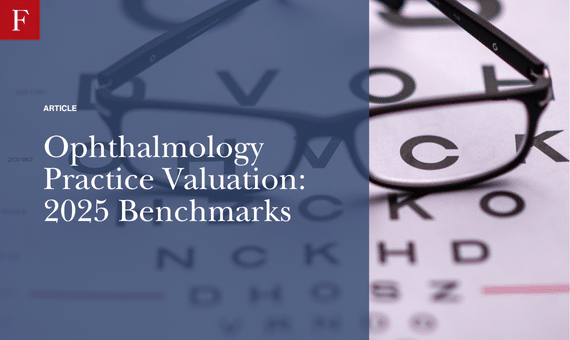
Ophthalmology Practice Valuation: 2025 Benchmarks
Private equity and strategic consolidators continue to view ophthalmology as one of the most attractive physician practice segments in 2025. The specialty combines procedural economics, demographic tailwinds, and ancillary revenue streams that create significant value for investors. As the market for independent ophthalmology practices tightens, understanding current valuation benchmarks has become essential for practice owners evaluating partnership opportunities, unsolicited offers, or strategic planning decisions.
This report provides standardized valuation ranges for ophthalmology practices. Whether you’re exploring a potential sale, benchmarking an inbound offer, or planning for long-term growth, these metrics offer a framework for understanding where your practice sits in today’s M&A landscape.
Current Valuation Ranges
Ophthalmology practices typically trade within the following ranges in 2025:
| Transaction Type | EBITDA Multiple | Revenue Multiple | Typical Profile |
|---|---|---|---|
| Platform Transactions (Initial Platform Investments, PE Exits, Large Combinations) |
12×–20× | ~1.0×–3× | Large groups with established infrastructure, management depth, and significant ancillary revenue |
| Add-On Transactions (Bolt-On Acquisitions) |
5×–10× | ~1.0×–3× | Smaller practices acquired by existing ophthalmology platforms to expand geographic coverage or clinical capabilities. Some very large add-on transactions can trade above 10× EBITDA |
*Actual pricing varies with each transaction based on many factors. Intended for educational purposes only and not a guarantee of any outcome.
The substantial gap between platform and add-on multiples reflects the infrastructure premium that buyers place on scale, management systems, and operational maturity. Buyers often pay several multiple turns higher for platform groups.
What Drives Premium Valuations in Ophthalmology
Several factors consistently push ophthalmology practices toward the upper end of valuation ranges:
Ambulatory Surgery Center (ASC) Ownership
ASC ownership remains the single most impactful value driver in ophthalmology M&A. Practices with owned surgery centers benefit from:
Procedural margin stability that helps insulate EBITDA from reimbursement volatility
Facility fee revenue that diversifies income beyond professional fees
Ability to better manage patient scheduling throughout the surgical care continuum
Ability to retain ancillary income for physicians, which acts as an alignment and recruiting tool
ASC ownership is typically associated with a valuation lift of 1–3 EBITDA multiple turns compared to clinic-only practices, assuming the ASC adds meaningful profitability to the transaction.
Retina Specialization
Retina-focused practices and comprehensive ophthalmology groups with significant retina capabilities can command premium valuations due to:
Clinical complexity and patient demand that creates referral moats and pricing power
Recurring patient relationships for chronic conditions requiring ongoing treatment
Injectable drug revenue streams from anti-VEGF therapies
Strategic buyer interest from pharmaceutical distributors seeking vertical integration
The 2024 acquisition of Retina Consultants of America by Cencora for $4.6 billion at an 18.4× EBITDA multiple underscores the strategic value pharmaceutical distributors place on retina platforms, though this represents an outlier transaction driven by unique synergies.
Multiple Revenue Streams
Practices that have diversified beyond traditional clinic visits may achieve higher multiples by demonstrating:
Optical retail operations generating cash-pay revenue, provided optical is a meaningful revenue and EBITDA driver (in some practices it can be a distraction)
A healthy premium lens and laser cataract surgery offering
Appropriate LASIK volumes
Diagnostic imaging (OCT, visual fields, fundus photography)
Dry eye and medical aesthetics services
This diversification reduces buyer risk by decreasing dependence on any single reimbursement stream and creates multiple expansion vectors for growth.
Physician Demographics and Succession Planning
The composition and age profile of the physician group significantly impacts valuation:
Younger physicians (especially partners) are viewed favorably by buyers and may support higher valuations
Clear succession plans and a history of successful recruiting reduce buyer execution risk
Physician retention agreements ensure clinical continuity post-transaction
Balanced partnership structure and low concentration among producers prevents key-person concentration
Practices with senior-heavy partner groups approaching retirement without documented succession plans typically face valuation discounts unless they can demonstrate strong recruiting pipelines.
Scale Effect on Ophthalmology Practice Valuations
Size matters in ophthalmology M&A. Larger practices with professional management infrastructure consistently attract higher multiples because they reduce buyer integration risk and demonstrate scalability.
Illustrative Valuation by EBITDA Scale
| EBITDA Range | Typical Valuation Range (EV/EBITDA) | Buyer Profile | Practice Characteristics |
|---|---|---|---|
| Under $1 Million | 5×–7× | Physician-to-physician transactions or small tuck-ins | Single-site practices without ASC ownership; limited management infrastructure |
| $1–3 Million | 7×–9× | Add-on acquisitions for existing platforms | Mid-sized groups with modest ancillaries; emerging operational systems |
| $3–5 Million | 9×–11× | Emerging platform or larger add-on | Multi-site operations with ASC ownership; partial management infrastructure |
| $5+ Million | 11×–13×+ | Platform-ready organization | Established management depth, multiple ASCs, sophisticated compliance and billing systems |
Practices approaching key EBITDA thresholds should recognize that incremental earnings growth can trigger step-changes in valuation multiples, not just linear increases in enterprise value, as documented across broader healthcare services transactions in 2024–2025.
Growth Trajectory and Expansion Potential
Buyers underwrite future cash flows, not historical performance alone. Practices that articulate credible growth plans may achieve premium valuations by demonstrating:
Organic Growth Levers
Provider recruitment plans with documented hiring pipelines (especially new providers who are ramping up)
Service line expansion into retina, oculoplastics, or medical aesthetics
Hour extension and capacity optimization at existing locations
Technology adoption that improves throughput or clinical outcomes
Buy or Build Inorganic Growth Opportunities
De novo site plans with market analysis and financial modeling
Tuck-in acquisition targets in adjacent markets
ASC development or partnership opportunities
Optical retail expansion or partnership with regional chains
Practices that can document historical execution of growth initiatives (new locations, successful physician or OD additions, ancillary service launches) earn credibility with buyers and justify forward-looking valuation premiums.
Preparing for a Premium Valuation
Practices seeking top-quartile outcomes should focus on:
| Category | Focus Area | Key Actions to Maximize Valuation |
|---|---|---|
| Financial Optimization | Ensure earnings are credible and defensible | • Normalize EBITDA with clear add-backs • Reset owner compensation to fair-market provider rates • Remove personal or one-time expenses • Prepare pro forma adjustments buyers will accept in diligence |
| Operational Excellence | Demonstrate strong infrastructure and compliance | • Document management systems and SOPs • Track KPIs monthly with trend analysis • Maintain clear physician contracts with transparent compensation and non-compete terms • Maintain compliance policies, training programs, and audit readiness |
| Growth Narrative | Present a credible forward plan | • Build a three-year strategic plan • Include a market opportunity analysis showing expansion runway • Outline capital investments for ASC development, equipment, and technology • Highlight execution on prior growth initiatives |
| Competitive Process | Leverage buyer interest through structure and representation | • Engage an investment banker to run a structured auction • Conduct targeted outreach to financial and strategic acquirers • Secure multiple term sheets to create competitive tension • Maintain negotiation leverage through qualified alternatives |
Current Market Dynamics
Several macro trends are shaping ophthalmology practice valuations in 2025:
| Macro Trend | Market Impact | Key Takeaways |
|---|---|---|
| Heightened Buyer Competition | Many PE platforms are vying for fewer remaining independent practices. | • Auctions are likely to attract multiple bidders • Buyers are often willing to stretch valuations for scarce assets, especially larger practices in active locations • Creative structures (earnouts, growth equity) are becoming more common • Speed and certainty of close now a differentiator |
| Strategic Buyer Entry | Pharmaceutical distributors, health systems, and other strategic buyers increasingly target ophthalmology for vertical integration. | • Control of drug distribution and specialty pharmacy • Care coordination for chronic disease management • Access to clinical and outcomes data • Strategic buyers may pay premiums when clear synergies exist |
| Interest Rate Environment | Higher interest rates have normalized peak 2021–2023 multiples, but core fundamentals keep valuations strong. | • Proven ophthalmology platform models attract lenders • Vision care seen as recession-resistant • Operational efficiency supports leverage • Demographic tailwinds sustain buyer conviction |
Conclusion
Ophthalmology practices consistently rank among the highest-valued physician specialty segments, with platform transactions often achieving 12–20× EBITDA and add-ons trading at 5–11× EBITDA in 2025. ASC ownership, retina specialization, multiple revenue streams, and favorable physician demographics drive valuations toward the upper end of these ranges.
Scale matters: practices crossing $3–5 million in EBITDA with professional management infrastructure often capture 2–4 additional multiple turns. Payor mix quality, growth trajectory, and operational excellence further differentiate top-quartile outcomes from market averages.
In a market characterized by strong buyer demand, limited independent practice supply, and demographic tailwinds, well-positioned ophthalmology practices with thoughtful pre-market preparation may achieve premium valuations even in a normalized interest rate environment. Understanding these benchmarks provides the foundation for strategic decision-making, whether evaluating partnership opportunities today or building enterprise value for a future transaction.
Learn More
FOCUS Investment Banking specializes in maximizing transaction value for healthcare practice owners through our proven quarterback approach to M&A advisory.
If you’d like to learn more about our healthcare investment banking services.
Sources:
FOCUS Investment Banking. “What is the Value of my Medical Practice?” (Eric Yetter, 2023). Focusbankers.com
DueDilio Industry Guide. “Healthcare Business Valuation: Methods, Metrics & Expert Tips” (June 2025). Duedilio.com
Peak Business Valuation. “Medical Practice Valuation Multiples” (June 2025). Peakbusinessvaluation.com
American Health Law Association. “Healthcare Transactions in 2024 – Notable Deals” (Ankura, April 2025). Americanhealthlaw.org
VMG Health. “A New Buyer in Physician Practice M&A – Strategic Transactions” (Tim Spadaro, October 2024). Vmghealth.com
Helix Health Capital. “EBITDA vs. EBPC: Valuation in Physician Practice Acquisitions” (Kayla Ballesteros, 2023). Helixhealthcapital.com
M&A Healthcare Advisors. “Understanding Value Based on EBITDA Multiples” (2023). Mahealthcareadvisors.com
Palladium Business Brokers. “How to Prepare Your Practice for Sale: A Checklist” (March 2025). Palladiumbb.com
Stifel. “HEALTHCARE SERVICES: Market Update February 2025” (February 2025). Stifel.com
Contact Eric Yetter ([email protected]) or Andy Snyder ([email protected]) today for a no-pressure conversation.





